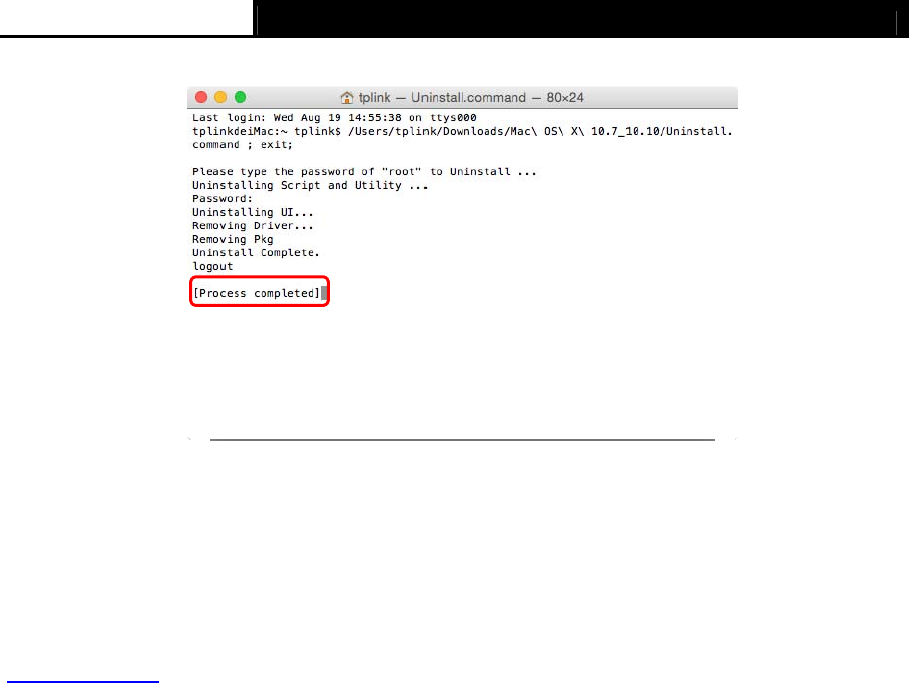TP Link Technologies T9UH AC1900 High Gain Wireless Dual Band USB Adapter User Manual Archer T9UH 2016 09 30
TP-Link Technologies Co., Ltd. AC1900 High Gain Wireless Dual Band USB Adapter Archer T9UH 2016 09 30
Archer T9UH_User Manual-2016-09-30
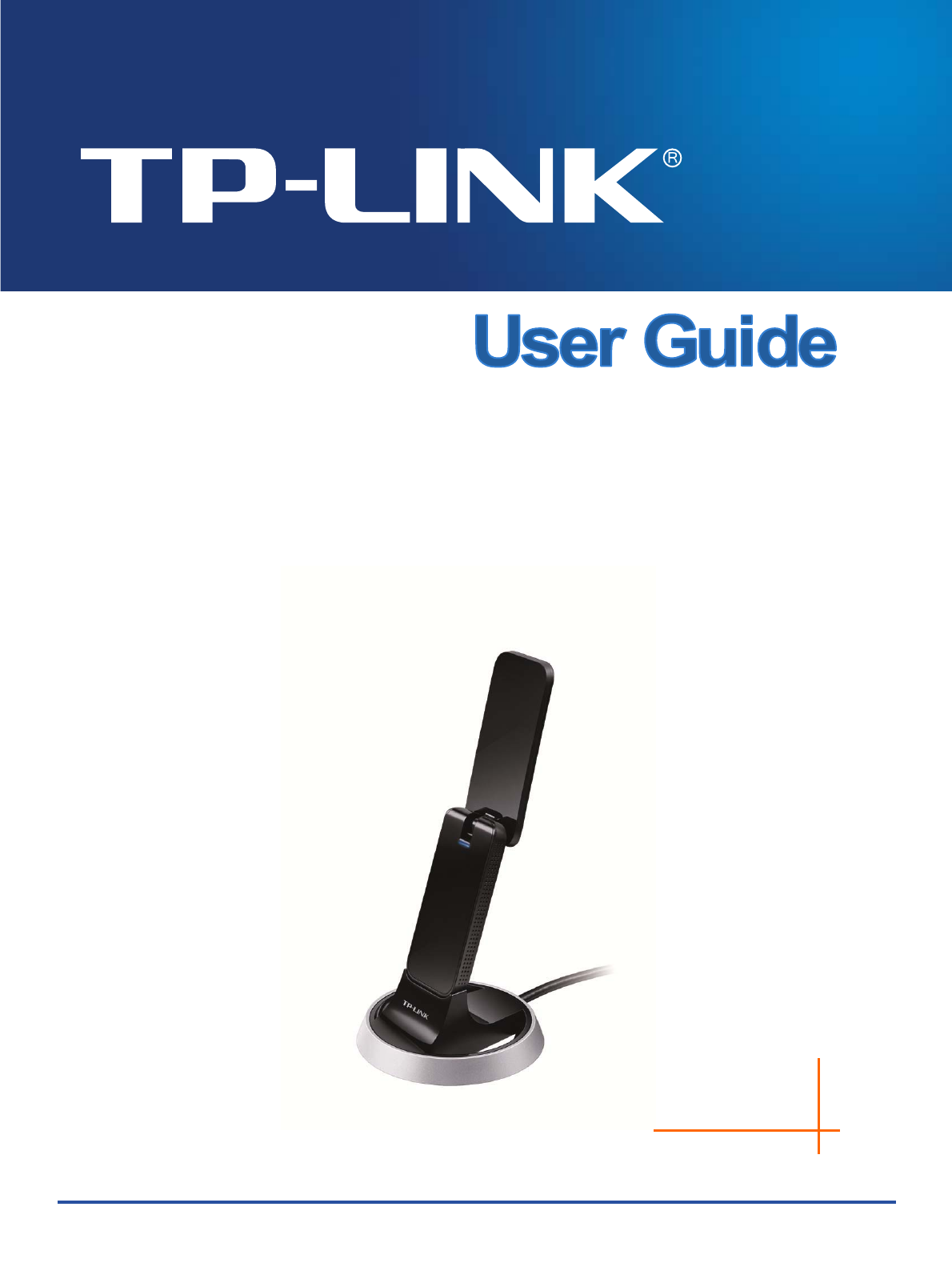
Archer T9UH
AC1900 High Gain Wireless Dual Band USB Adapter
REV1.0.0
1910011567

COPYRIGHT & TRADEMARKS
Specifications are subject to change without notice. is a registered trademark of
TP-LINK TECHNOLOGIES CO., LTD. Other brands and product names are trademarks or
registered trademarks of their respective holders.
No part of the specifications may be reproduced in any form or by any means or used to make
any derivative such as translation, transformation, or adaptation without permission from
TP-LINK TECHNOLOGIES CO., LTD. Copyright © 2016 TP-LINK TECHNOLOGIES CO., LTD.
All rights reserved.
http://www.tp-link.com

FCC STATEMENT
This equipment has been tested and found to comply with the limits for a Class B digital device,
pursuant to part 15 of the FCC Rules. These limits are designed to provide reasonable
protection against harmful interference in a residential installation. This equipment generates,
uses and can radiate radio frequency energy and, if not installed and used in accordance with
the instructions, may cause harmful interference to radio communications. However, there is no
guarantee that interference will not occur in a particular installation. If this equipment does
cause harmful interference to radio or television reception, which can be determined by turning
the equipment off and on, the user is encouraged to try to correct the interference by one or
more of the following measures:
Reorient or relocate the receiving antenna.
Increase the separation between the equipment and receiver.
Connect the equipment into an outlet on a circuit different from that to which the receiver is
connected.
Consult the dealer or an experienced radio/ TV technician for help.
This device complies with part 15 of the FCC Rules. Operation is subject to the following two
conditions:
1) This device may not cause harmful interference.
2) This device must accept any interference received, including interference that may cause
undesired operation.
Any changes or modifications not expressly approved by the party responsible for compliance
could void the user’s authority to operate the equipment.
Note: The manufacturer is not responsible for any radio or TV interference caused by
unauthorized modifications to this equipment. Such modifications could void the user’s authority
to operate the equipment.
FCC RF Radiation Exposure Statement:
This equipment complies with FCC radiation exposure limits set forth for an uncontrolled
environment. End users must follow the specific operating instructions for satisfying RF
exposure compliance. This transmitter must not be co-located or operating in conjunction with
any other antenna or transmitter. This equipment has been SAR-evaluated for use in hand.
SAR measurements are based on a 5mm spacing from the body and that compliance is
achieved at that distance.
This device is restricted in indoor environment only.
CE Mark Warning

RF Exposure Information
This device meets the EU requirements (1999/5/EC Article 3.1a) on the limitation of exposure of
the general public to electromagnetic fields by way of health protection.
The device complies with RF specifications when the device used at 5 cm from your body.
Restricted to indoor use.
Canadian Compliance Statement
This device complies with Industry Canada license-exempt RSSs. Operation is subject to the
following two conditions:
1) This device may not cause interference, and
2) This device must accept any interference, including interference that may cause undesired
operation of the device.
Le présent appareil est conforme aux CNR d’Industrie Canada applicables aux appareils radio
exempts de licence. L’exploitation est autorisée aux deux conditions suivantes :
1) l’appareil ne doit pas produire de brouillage;
2) l’utilisateur de l’appareil doit accepter tout brouillage radioélectrique subi, meme si le
brouillage est susceptible d’en compromettre le fonctionnement.
This radio transmitter (IC: 8853A-T9UH/ Model: Archer T9UH) has been approved by Industry
Canada to operate with the antenna types listed below with the maximum permissible gain
indicated. Antenna types not included in this list (Appendix A), having a gain greater than the
maximum gain indicated for that type, are strictly prohibited for use with this device.
Le présent émetteur radio (IC: 8853A-T9UH/ Model: Archer T9UH) a été approuvé par Industrie
Canada pour fonctionner avec les types d'antenne énumérés ci-dessous et ayant un gain
admissible maximal. Les types d'antenne non inclus dans cette liste (Annexe A), et dont le gain
est supérieur au gain maximal indiqué, sont strictement interdits pour l'exploitation de l'émetteur.
Caution:
1) The device for operation in the band 5150–5250 MHz is only for indoor use to reduce the
potential for harmful interference to co-channel mobile satellite systems;
2) For devices with detachable antenna(s), the maximum antenna gain permitted for devices in
the bands 5250-5350 MHz and 5470-5725 MHz shall be such that the equipment still
complies with the e.i.r.p. limit;
3) For devices with detachable antenna(s), the maximum antenna gain permitted for devices in
the band 5725-5850 MHz shall be such that the equipment still complies with the e.i.r.p. limits
specified for point-to-point and non-point-to-point operation as appropriate; and
The high-power radars are allocated as primary users (i.e. priority users) of the bands
5250-5350 MHz and 5650-5850 MHz and that these radars could cause interference and/or
damage to LE-LAN devices.
DFS (Dynamic Frequency Selection) products that operate in the bands 5250- 5350 MHz,
5470-5600MHz, and 5650-5725MHz.
Avertissement:
1) Le dispositif fonctionnant dans la bande 5150-5250 MHz est réservé uniquement pour une
utilisation à l’intérieur afin de réduire les risques de brouillage préjudiciable aux systèmes de
satellites mobiles utilisant les mêmes canaux;
2) Le gain maximal d'antenne permis pour les dispositifs avec antenne(s) amovible(s) utilisant
les bandes 5250-5350 MHz et 5470-5725 MHz doit se conformer à la limitation P.I.R.E.;
3) Le gain maximal d'antenne permis pour les dispositifs avec antenne(s) amovible(s) utilisant
la bande 5725-5850 MHz doit se conformer à la limitation P.I.R.E spécifiée pour l’exploitation
point à point et non point à point, selon le cas.
En outre, les utilisateurs devraient aussi être avisés que les utilisateurs de radars de haute
puissance sont désignés utilisateurs principaux (c.-à-d., qu’ils ont la priorité) pour les bandes
5250-5350 MHz et 5650-5850 MHz et que ces radars pourraient causer du brouillage et/ou des
dommages aux dispositifs LAN-EL.
Les produits utilisant la technique d'atténuation DFS (sélection dynamique des fréquences) sur
les bandes 5250- 5350 MHz, 5470-5600MHz et 5650-5725MHz.
Radiation Exposure Statement:
This equipment complies with IC radiation exposure limits set forth for an uncontrolled
environment. This equipment should be installed and operated with minimum distance 20cm
between the radiator & your body.
Déclaration d'exposition aux radiations:
Cet équipement est conforme aux limites d'exposition aux rayonnements IC établies pour un
environnement non contrôlé. Cet équipement doit être installé et utilisé avec un minimum de 20
cm de distance entre la source de rayonnement et votre corps.
Industry Canada Statement
CAN ICES-3 (B)/NMB-3(B)
Korea Warning Statements
당해 무선설비는 운용중 전파혼신 가능성이 있음.
NCC Notice
注意!
依據 低功率電波輻射性電機管理辦法

第十二條 經型式認證合格之低功率射頻電機,非經許可,公司、商號或使用者均不得擅自變更頻
率、加大功率或變更原設計之特性或功能。
第十四條 低功率射頻電機之使用不得影響飛航安全及干擾合法通行;經發現有干擾現象
時,應立即停用,並改善至無干擾時方得繼續使用。前項合法通信,指依電信規定作業之無線電
信。低功率射頻電機需忍受合法通信或工業、科學以及醫療用電波輻射性電機設備之干擾。
減少電磁波影響,請妥適使用。
於5.25GHz 至5.35GHz 區域內操作之無線設備的警告聲明
工作頻率 5.250~5.350GHz 該頻段限於室內使用。
BSMI Notice
安全諮詢及注意事項
請使用原裝電源供應器或只能按照本產品注明的電源類型使用本產品。
清潔本產品之前請先拔掉電源線。請勿使用液體、噴霧清潔劑或濕布進行清潔。
注意防潮,請勿將水或其他液體潑灑到本產品上。
插槽與開口供通風使用,以確保本產品的操作可靠並防止過熱,請勿堵塞或覆蓋開口。
請勿將本產品置放於靠近熱源的地方。除非有正常的通風,否則不可放在密閉位置中。
請不要私自打開機殼,不要嘗試自行維修本產品,請由授權的專業人士進行此項工作。
Продукт сертифіковано згідно с правилами системи УкрСЕПРО на відповідність вимогам
нормативних документів та вимогам, що передбачені чинними законодавчими актами
України.
Safety Information
When product has power button, the power button is one of the way to shut off the product;
when there is no power button, the only way to completely shut off power is to disconnect
the product or the power adapter from the power source.
Don’t disassemble the product, or make repairs yourself. You run the risk of electric shock
and voiding the limited warranty. If you need service, please contact us.
Avoid water and wet locations.

For EU/EFTA, this product can be used in the following countries:
AT BE BG HR CY CZ DK EE
FI FR DE GR HU IE IT LV
LT LU MT NL PL RO PT SK
SI ES SE GB IS LI NO CH
Explanation of the symbols on the product label
Symbol Explanation
DC voltage
RECYCLING
This product bears the selective sorting symbol for Waste electrical and electronic
equipment (WEEE). This means that this product must be handled pursuant to
European directive 2012/19/EU in order to be recycled or dismantled to minimize
its impact on the environment.
User has the choice to give his product to a competent recycling organization or to
the retailer when he buys a new electrical or electronic equipment.

TP-LINK TECHNOLOGIES CO., LTD
TP-LINK TECHNOLOGIES CO., LTD.
Building 24 (floors 1, 3, 4, 5), and 28 (floors 1-4) Central Science and Technology Park,
Shennan Rd, Nanshan, Shenzhen, China
DECLARATION OF CONFORMITY
For the following equipment:
Product Description: AC1900 High Gain Wireless Dual Band USB Adapter
Model No.: Archer T9UH
Trademark: TP-LINK
We declare under our own responsibility that the above products satisfy all the technical
regulations applicable to the product within the scope of Council Directives:
Directives 1999/5/EC, Directives 2011/65/EU
The above product is in conformity with the following standards or other normative documents
EN 300 328 V1.9.1
EN 301 893 V1.8.1
EN 301 489-1 V1.9.2 & EN 301 489-17 V2.2.1
EN 55022: 2010 + AC: 2011
EN 61000-3-2:2014
EN 61000-3-3:2013
EN 55024: 2010
EN 60950-1: 2006 + A11: 2009 + A1: 2010 + A12: 2011 +A2: 2013
EN 50566: 2013
EN 50581: 2012
The product carries the CE Mark:
Person responsible for making this declaration:
Yang Hongliang
Product Manager of International Business
Date of issue: 2016-02-26
CONTENTS
Chapter 1Product Overview ................................................................................. 1
1.1Introduction ............................................................................................................. 1
1.2Features.................................................................................................................. 1
1.3LED Status.............................................................................................................. 1
Chapter 2Connect to a Computer ........................................................................ 2
Chapter 3Windows ................................................................................................ 3
3.1Install Driver and Utility ........................................................................................... 3
3.2Join a Wireless Network.......................................................................................... 5
3.3Uninstall Driver........................................................................................................ 5
Chapter 4Mac OS X ............................................................................................... 6
4.1Install Driver and Utility ........................................................................................... 6
4.2Join a Wireless Network........................................................................................ 10
4.2.1TP-LINK Utility.......................................................................................... 11
4.2.2WPS (Wi-Fi Protected Setup)................................................................... 12
4.3Management ......................................................................................................... 15
4.3.1Link Status ............................................................................................... 16
4.3.2Profiles ..................................................................................................... 16
4.4Uninstall Driver and Utility ..................................................................................... 18
Chapter 5Linux .................................................................................................... 20
Appendix A: Specifications................................................................................... 21
Appendix B: Glossary............................................................................................ 22

Archer T9UH AC1900 High Gain Wireless Dual Band USB Adapter User Guide
1
Chapter 1 Product Overview
1.1 Introduction
The TP-LINK Archer T9UH AC1900 High Gain Wireless Dual Band USB Adapter connects your
notebook or desktop computer over Wi-Fi to an 11ac or other network for applications such as
lag-free video streaming, online gaming, and secure Internet surfing.
1.2 Features
Supports 802.11ac standard
Seamlessly compatible with 802.11a/b/g/n/ac products
USB 3.0 port
Dual Band connections for lag-free HD video streaming and gaming
Maximum speed of up to 1300Mbps for 5GHz network and up to 600Mbps for 2.4GHz
network
Supports ad-hoc and infrastructure mode
Easy wireless security encryption at a push of the WPS button
Supports 64/128 WEP, WPA/WPA2, WPA-PSK/WPA2-PSK(TKIP/AES), supports IEEE
802.1x
Easy Wireless Configuration Utility (for Mac OS X 10.7 – 10.10 only)
Supports Windows 10/8.1/8/7/XP 32/64bit, Mac OS X 10.7 - 10.10, Linux
1.3 LED Status
Status Working Status
Off
The driver has not been installed.
The adapter's radio has been disabled.
Flashing Slowly The driver is installed but is not connected to the Internet.
Solid On The adapter is connected to the Internet.
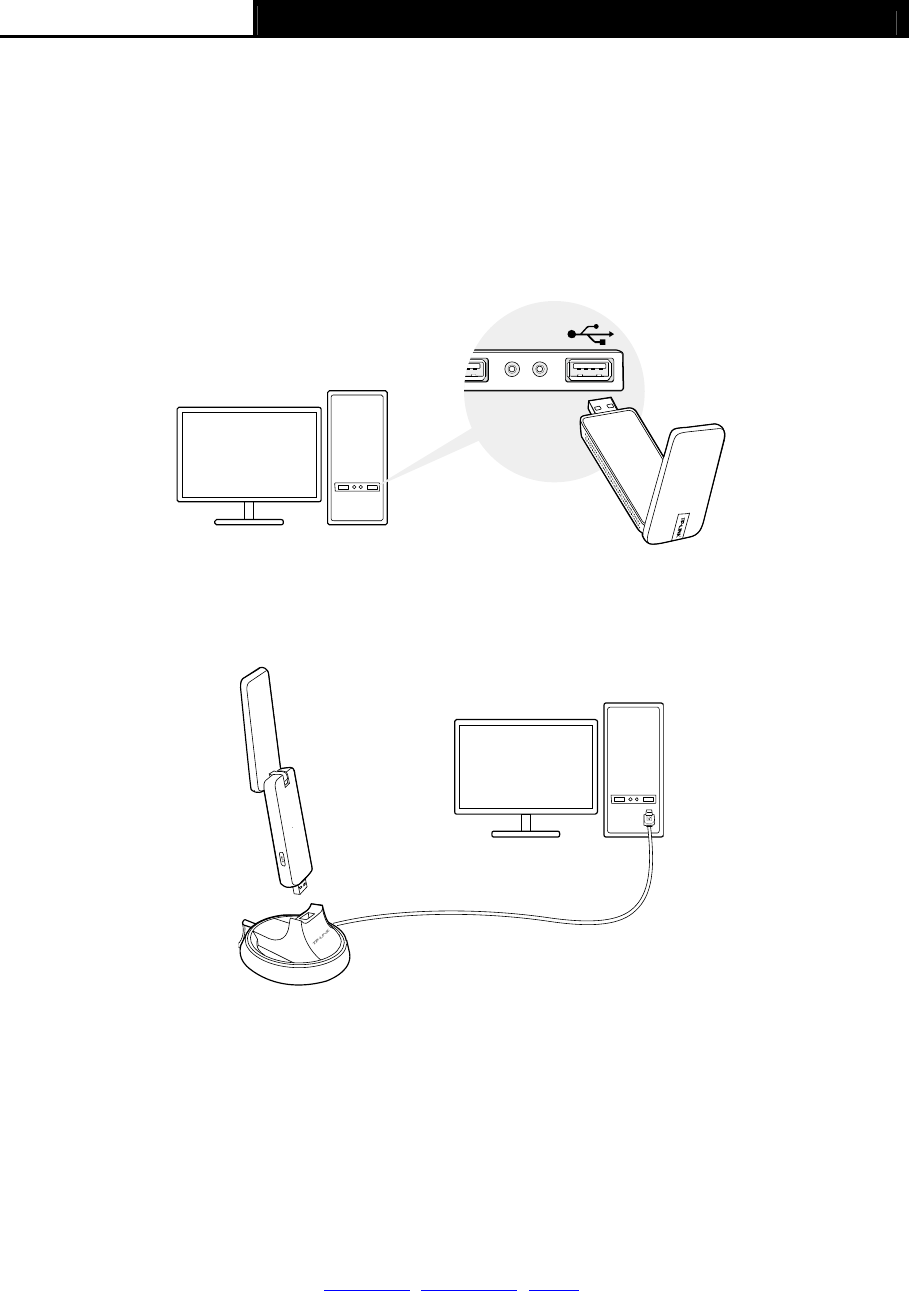
Archer T9UH AC1900 High Gain Wireless Dual Band USB Adapter User Guide
2
Chapter 2 Connect to a Computer
Before you begin using your adapter, connect the adapter to your computer.
Option 1: Directly
Insert the adapter into a USB port on your computer directly.
Option 2: Via the USB Extension Cable
Connect the adapter and your computer with the provided USB extension cable.
Note:
In Windows XP, a Found New Hardware Wizard window will appear when the adapter is
detected. Please click Cancel.
The adapter provides the best performance with a USB 3.0 port and is also compatible with
a USB 2.0 or USB 1.1 port.
After connecting your adapter to the computer, please follow the instructions in the appropriate
chapter for your operating system: Windows, Mac OS X, Linux.
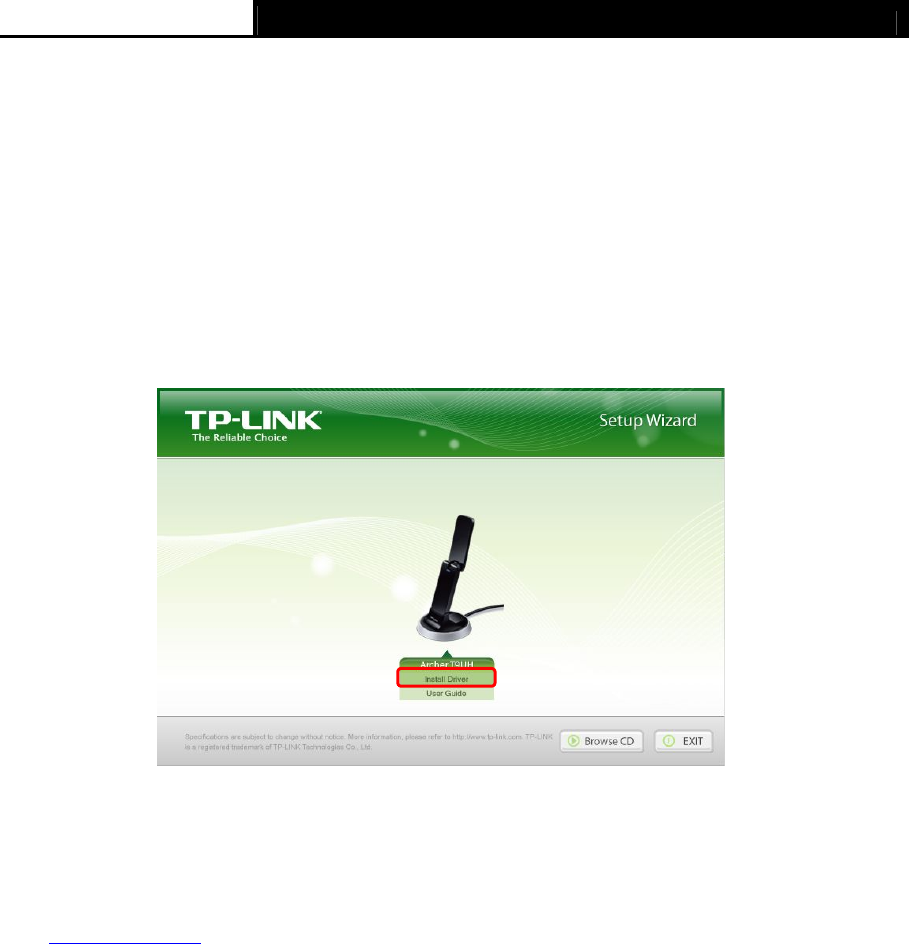
Archer T9UH AC1900 High Gain Wireless Dual Band USB Adapter User Guide
3
Chapter 3 Windows
3.1 Install Driver
The Setup Wizard will guide you through the installation procedures. We use the procedures in
Windows 7 as an example - the procedures may vary slightly for other versions of Windows.
1. Insert the resource CD into your CD drive and run the Autorun.exe from the pop-up
AutoPlay window. Select Archer T9UH and click Install Driver to begin.
Note:
The CD is included in the package. If your CD does not work or your computer doesn't
support the CD, you can also download the driver from the TP-LINK website
(www.tp-link.com).
In some operating systems, the CD screen will pop up automatically. Otherwise, run the CD
manually.

Archer T9UH AC1900 High Gain Wireless Dual Band USB Adapter User Guide
4
2. The InstallShield Wizard window displays. Click Next to continue.
3. Click Install. After a few minutes, the installation completes. Click Finish.
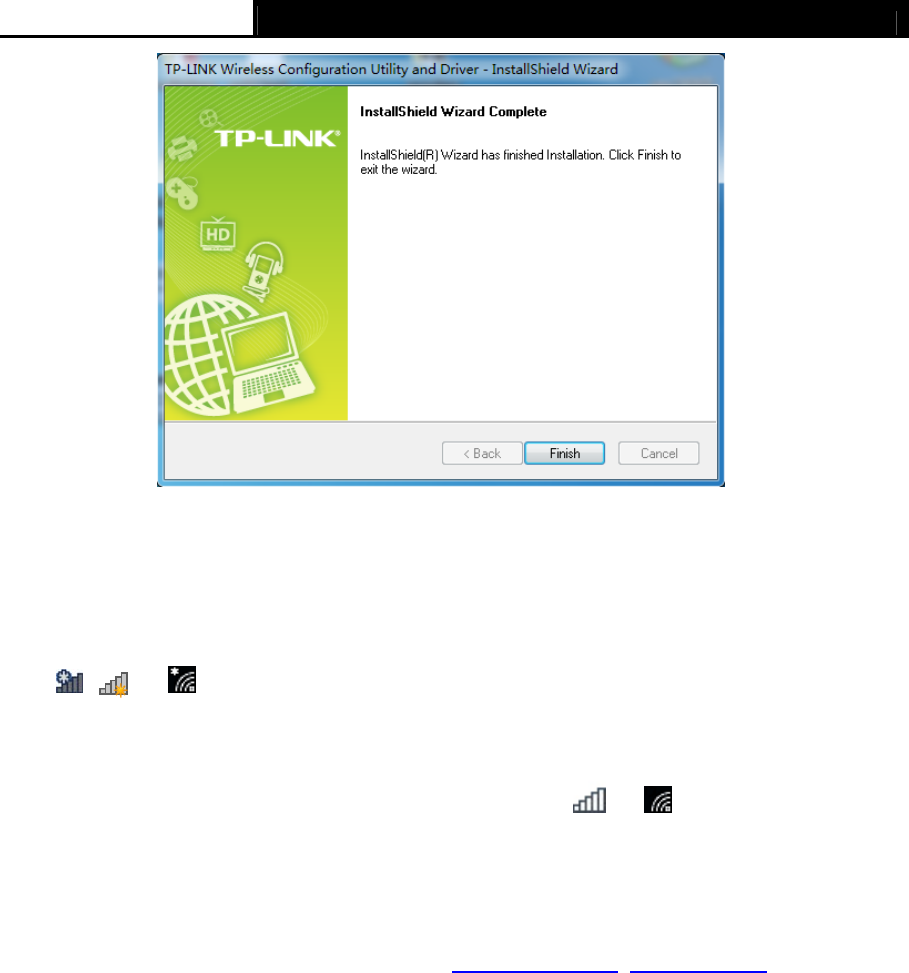
Archer T9UH AC1900 High Gain Wireless Dual Band USB Adapter User Guide
5
3.2 Join a Wireless Network
You can use the Windows WLAN Autoconfig service (for Windows 10/8.1/8/7) and the Wireless
Zero Configuration service (for Windows XP) to join a Wi-Fi network.
Click , or (Network icon) on the taskbar. Select the Wi-Fi network you want to join,
and click Connect. Enter your Wi-Fi password when prompted.
That’s it, you are connected! The network icon will change to or .
3.3 Uninstall Driver
The software uninstallation steps vary a bit in different systems, please follow the appropriate
instructions for your Windows operating system: Windows 8/8.1/10, Windows XP/7.
Windows 8/8.1/10
Go to Start > Apps or All apps, and find the TP-LINK application. Click Uninstall - TP-LINK
Archer T9UH Driver, then follow the on-screen instructions to complete the uninstallation.
Windows XP/7
Go to Start > All Programs > TP-LINK > Uninstall - TP-LINK Archer T9UH Driver. Follow the
on-screen instructions to complete the uninstallation.
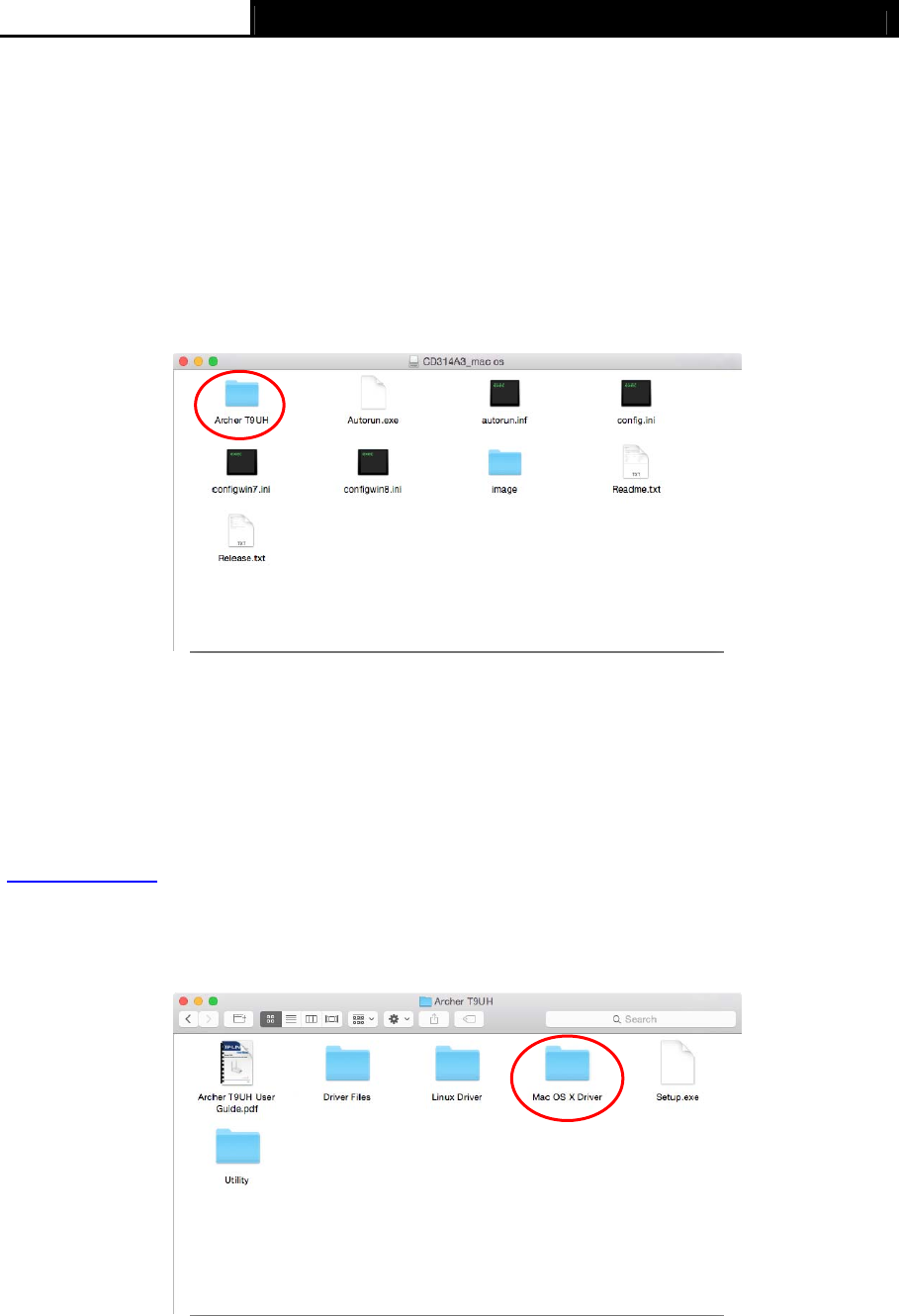
Archer T9UH AC1900 High Gain Wireless Dual Band USB Adapter User Guide
6
Chapter 4 Mac OS X
4.1 Install Driver and Utility
We take the procedures in Mac OS X 10.10 as an example - the procedures may vary slightly
for other versions of Mac OS.
1. Insert the CD and run it manually. Open the Archer T9UH folder.
Note:
The CD is included in the package. If your CD does not work or your computer doesn't support
the CD, you can also download the driver and utility from the TP-LINK website
(www.tp-link.com).
2. Open the Mac OS X Driver folder.
3. Double-click the Mac OS X 10.7_10.10.zip file. It will be unzipped into the Download
folder automatically.
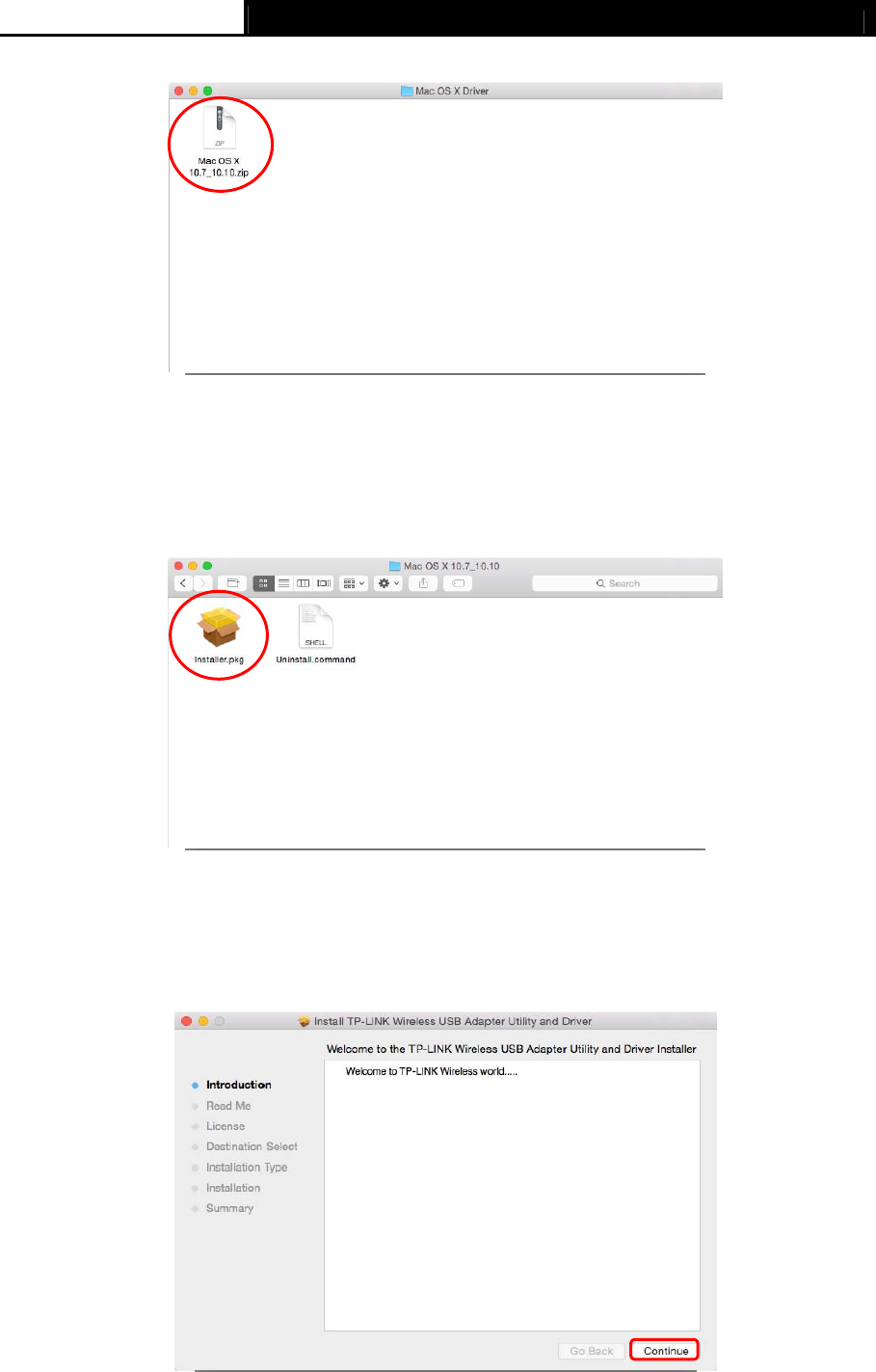
Archer T9UH AC1900 High Gain Wireless Dual Band USB Adapter User Guide
7
4. Open the Mac OS X 10.7_10.10 folder, double click the Installer.pkg file to open the
installation wizard.
5. The Install TP-LINK Wireless USB Adapter Utility and Driver Wizard window will appear.
Click Continue and follow the wizard to continue the installation.
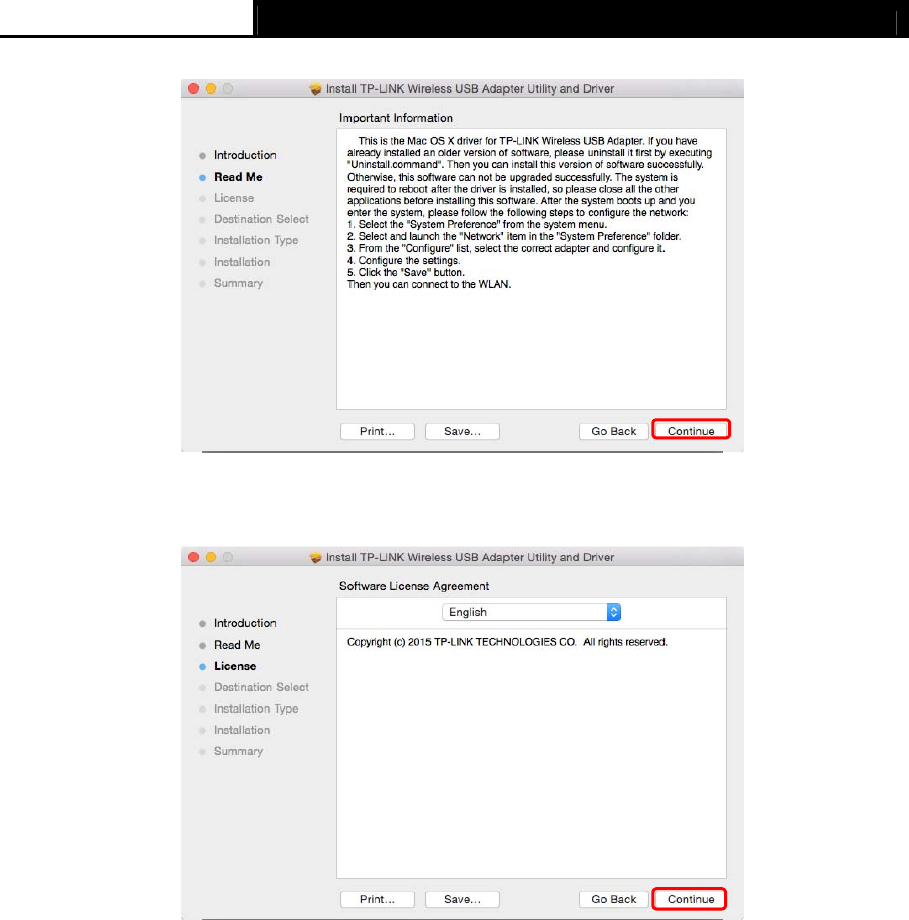
Archer T9UH AC1900 High Gain Wireless Dual Band USB Adapter User Guide
8
Note:
The language of this utility is in accordance with the language of your computer by default, and
any change of it is invalid.
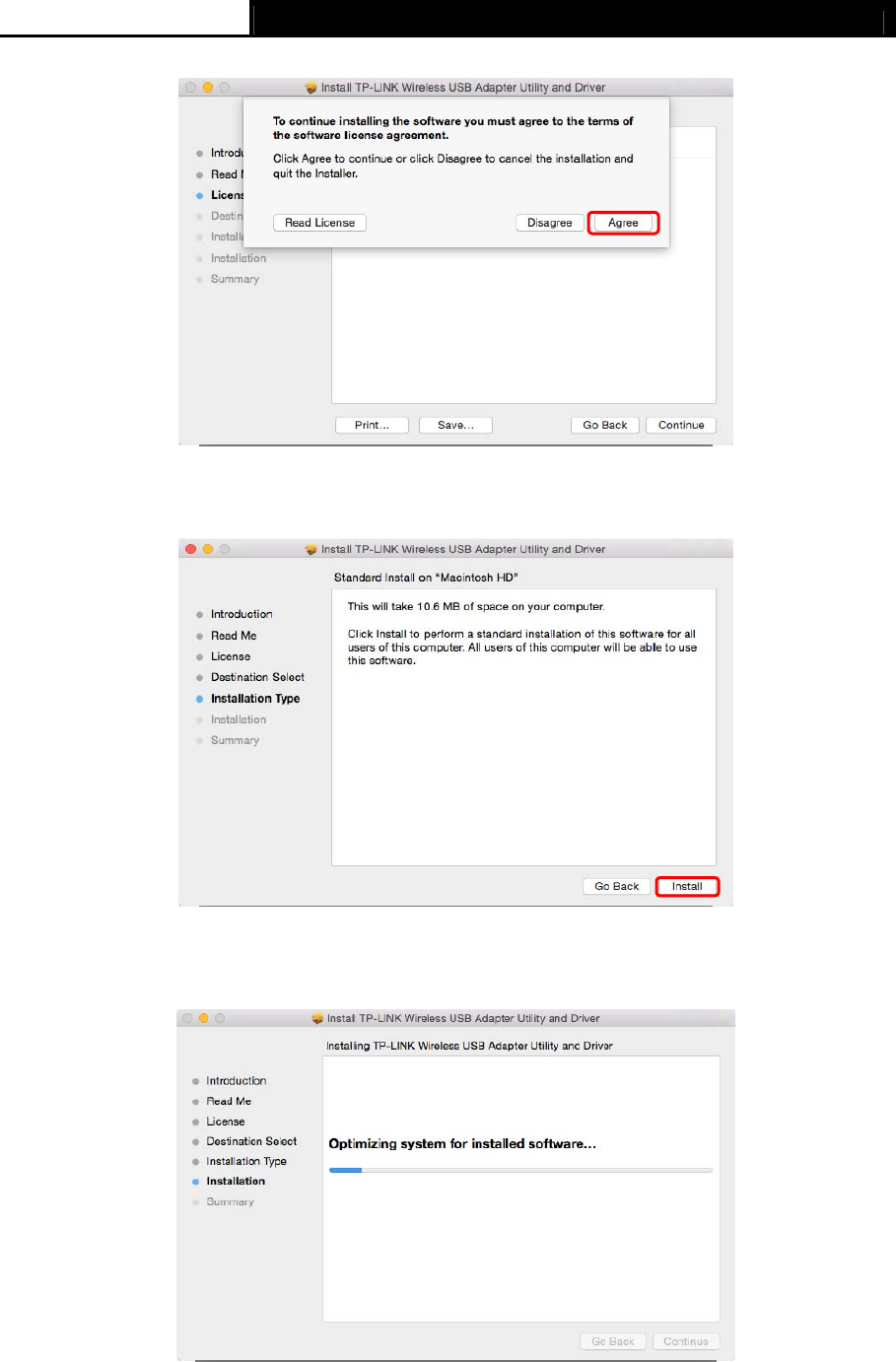
Archer T9UH AC1900 High Gain Wireless Dual Band USB Adapter User Guide
9
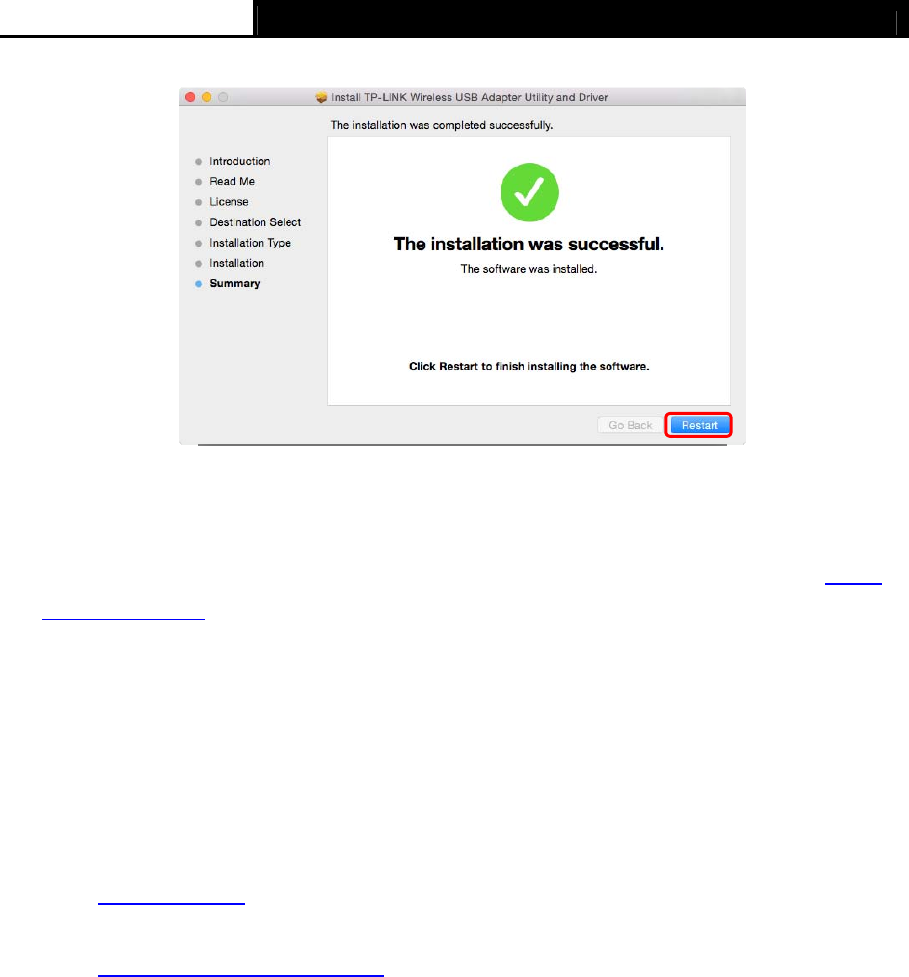
Archer T9UH AC1900 High Gain Wireless Dual Band USB Adapter User Guide
10
6. After restarting the computer, the TP-LINK utility will pop up automatically. You can use the
utility to join a Wi-Fi network with your adapter. For more guidance, please refer to Join a
Wireless Network.
Note:
If the TP-LINK Utility does not pop up automatically, make sure the USB wireless network
adapter is connected properly and the LED is on.
4.2 Join a Wireless Network
There are two options of using the adapter to join a Wi-Fi network.
Option 1: TP-LINK Utility
TP-LINK Utility lets you easily connect the adapter to a Wi-Fi network and manage the adapter.
Option 2: WPS (Wi-Fi Protected Setup)
WPS (Wi-Fi Protected Setup) is a network security standard for easily adding computers and
other devices to a home network. Use this method if your wireless router or access point
supports WPS.
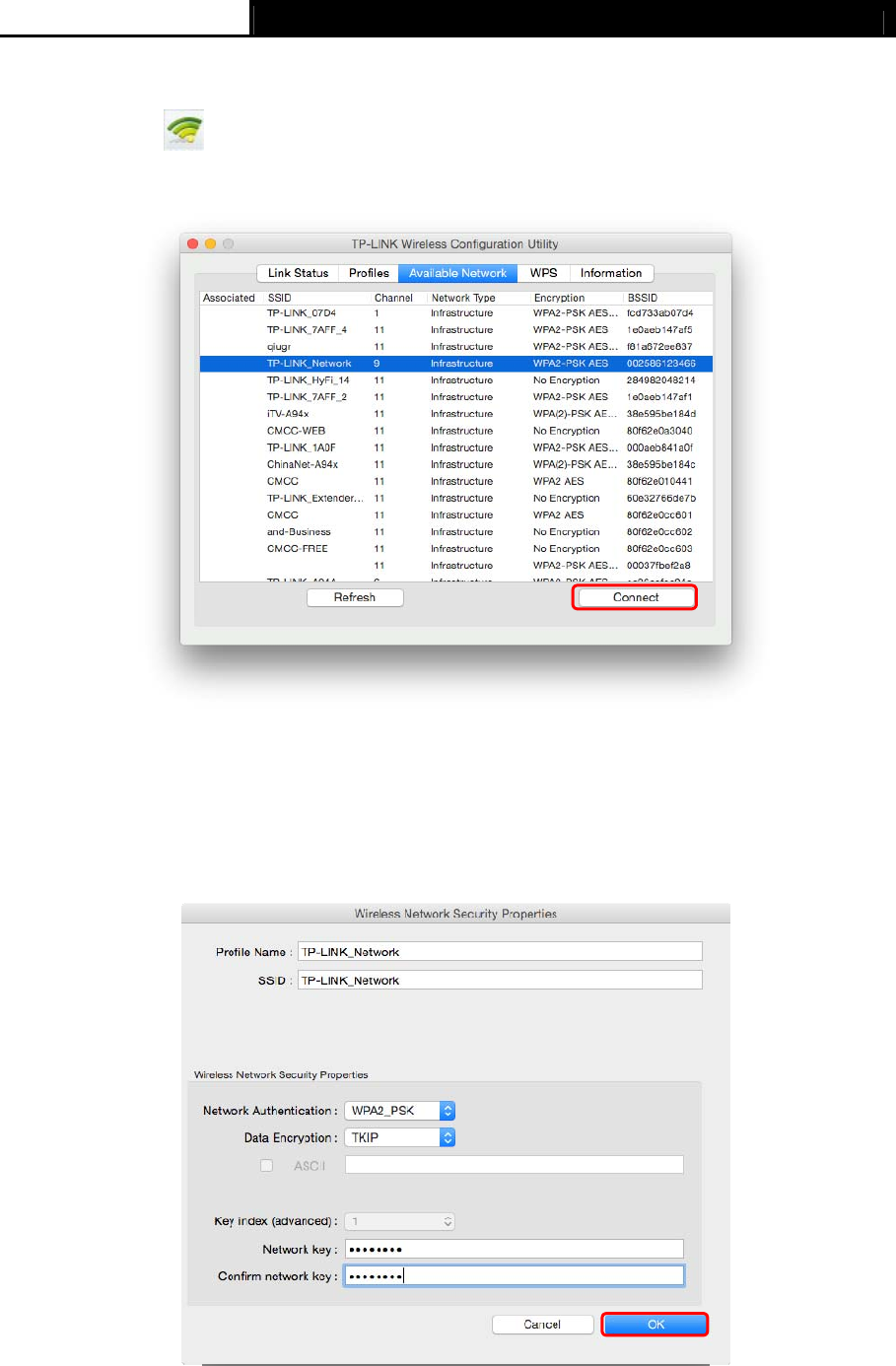
Archer T9UH AC1900 High Gain Wireless Dual Band USB Adapter User Guide
11
4.2.1 TP-LINK Utility
1. Double-click (TP-LINK Utility icon) and select Available Network tab. Then select
the network you want to join from the list and click Connect.
2. The wireless network security properties screen displays. If your network uses wireless
security, you will be prompted to enter the Wi-Fi password of the network in the blank field
next to Network key, and enter it again in the blank field next to Confirm network key.
Click OK.
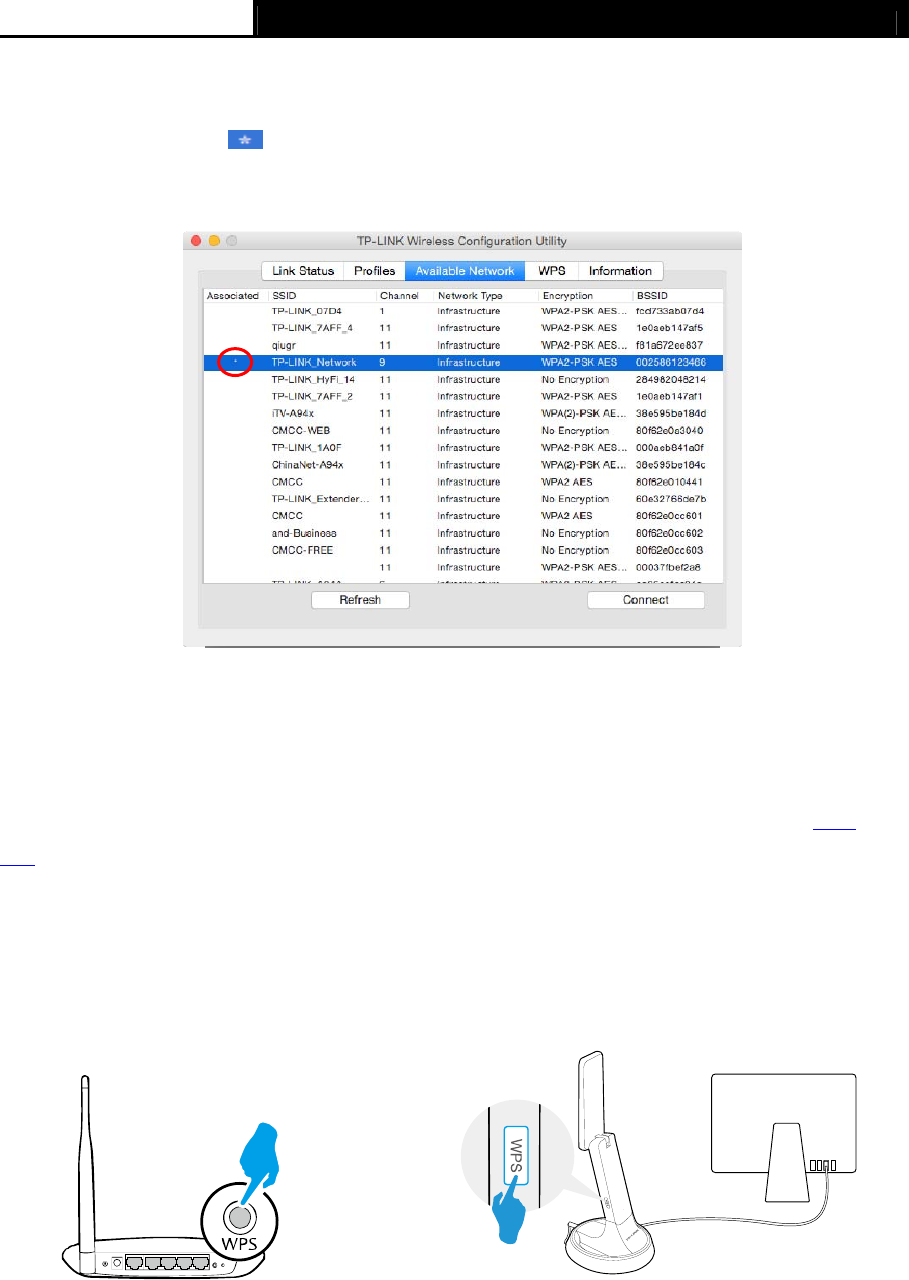
Archer T9UH AC1900 High Gain Wireless Dual Band USB Adapter User Guide
12
3. After successfully connecting to your network, it will switch to Link Status screen
automatically, which will show the network status. If you select Available Network tab, you
will see a symbol in front of your network’s SSID, which indicates a successful
connection.
4.2.2 WPS (Wi-Fi Protected Setup)
WPS can be activated via PBC (Push Button Configuration) and PIN. Please refer to PBC or
PIN below.
PBC
Option 1
1. Press the WPS/QSS button on your router or AP. Within 2 minutes, press and hold the
WPS button on the adapter until the following screen appears.
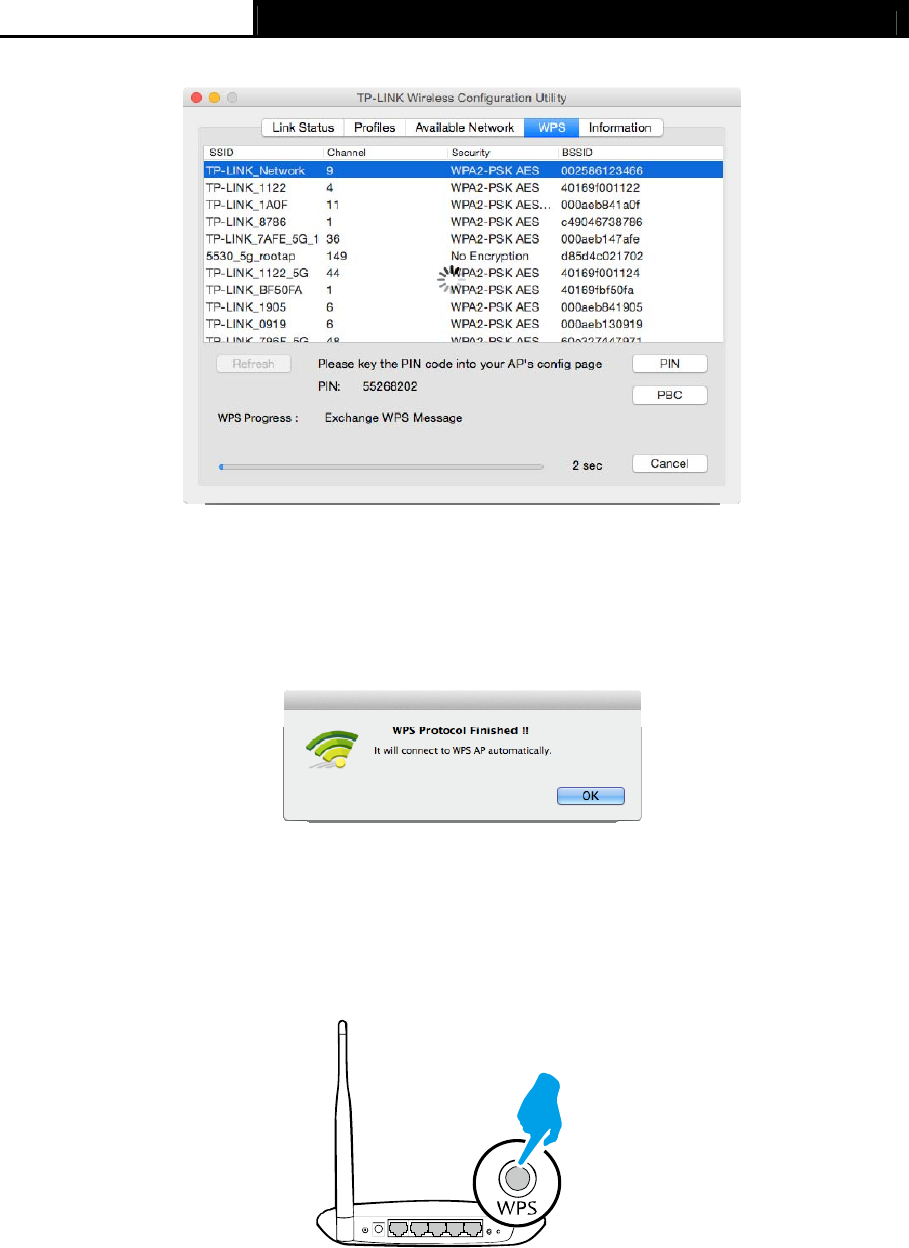
Archer T9UH AC1900 High Gain Wireless Dual Band USB Adapter User Guide
13
2. The following screen indicates a successful connection by WPS. Click OK.
Option 2
1. Press the WPS/QSS button on your router or AP.
2. Within 2 minutes, open TP-LINK Utility and click WPS tab. Click PBC.
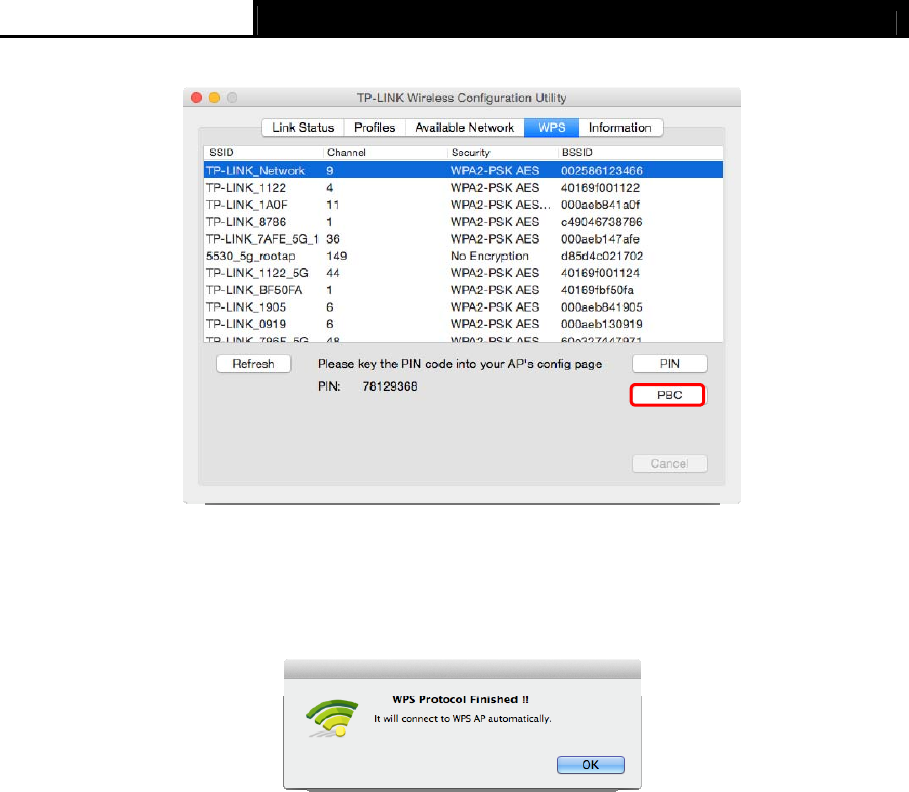
Archer T9UH AC1900 High Gain Wireless Dual Band USB Adapter User Guide
14
3. The following screen indicates a successful connection by WPS. Click OK.
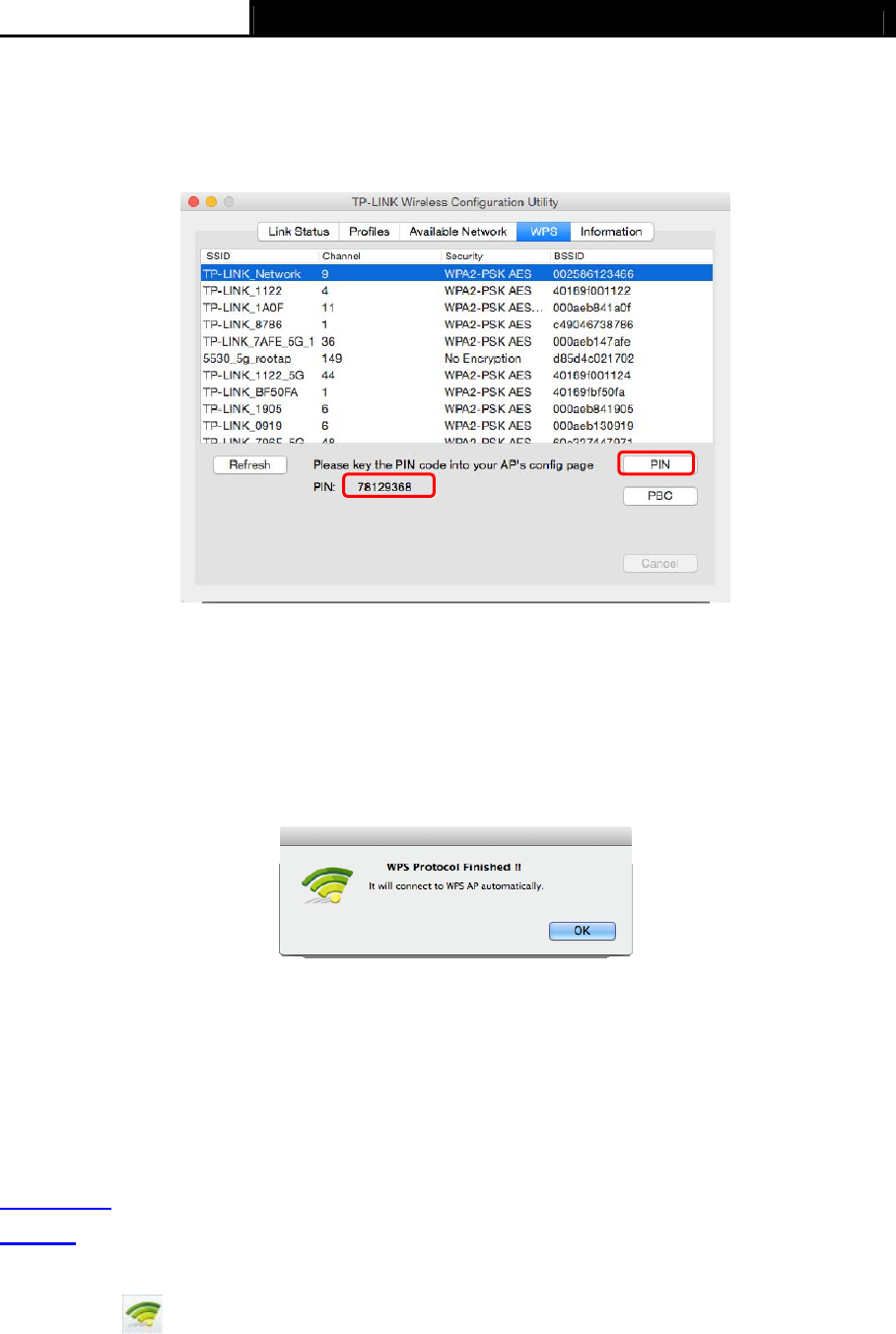
Archer T9UH AC1900 High Gain Wireless Dual Band USB Adapter User Guide
15
PIN
1. Open TP-LINK Utility and click WPS tab. Mark down the PIN displayed on the screen, and
click PIN.
2. Within 2 minutes, log in to the Web Management page of your router or AP. Go to its WPS
page, enter the PIN of the adapter in the corresponding field and click Connect.
3. The following screen indicates a successful connection by WPS. Click OK.
4.3 Management
TP-LINK Utility provides you with an easy way to manage your adapter. It includes the following
sections:
Link Status - View the information of the current Wi-Fi network connection and of the adapter.
Profiles - Save or manage various Wi-Fi network connection settings.
Information - View the utility version and the driver version of your adapter.
Double-click (TP-LINK Utility icon) and click the Link Status, Profiles or Information tab
to manage the corresponding section of your adapter.
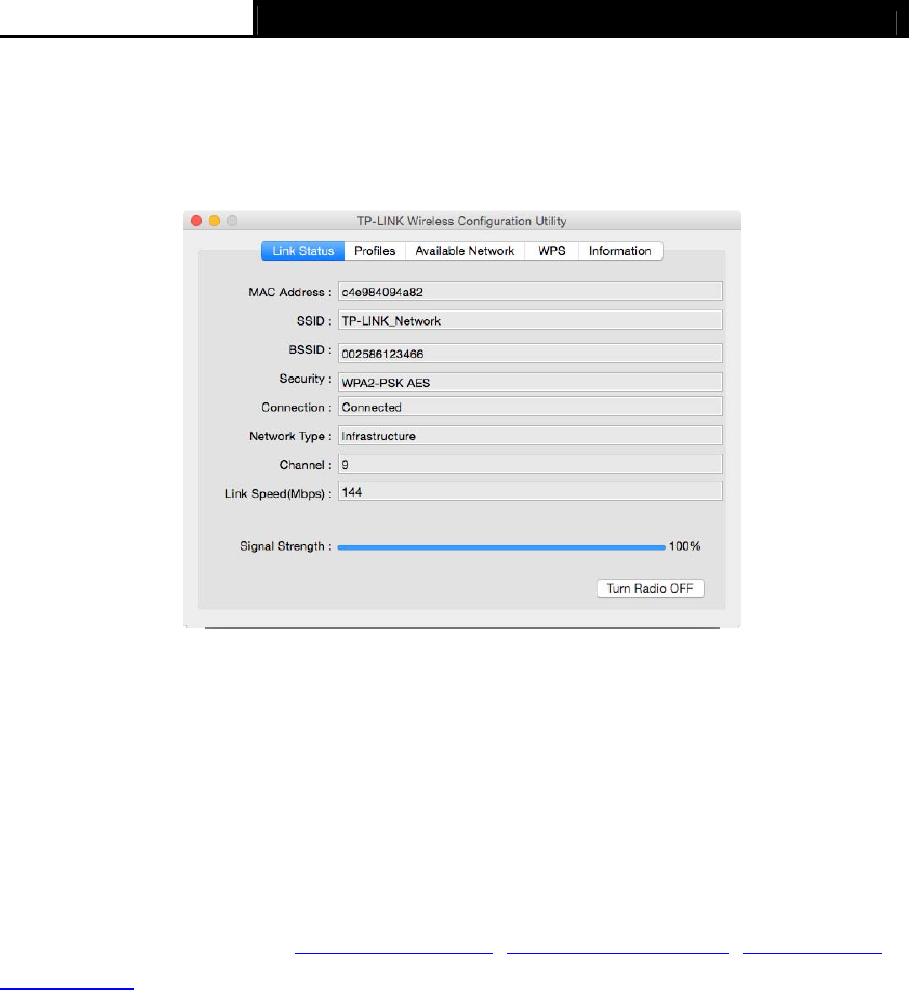
Archer T9UH AC1900 High Gain Wireless Dual Band USB Adapter User Guide
16
4.3.1 Link Status
You can view the signal strength of the Wi-Fi network, the MAC address of the adapter and
other information of the link status as shown in the following figure.
4.3.2 Profiles
The Profiles screen lets you save and manage different Wi-Fi network connection settings as
profiles so that you can quickly and simply connect to your network. Moreover, you can join a
hidden Wi-Fi network that does not broadcast its SSID by adding a profile, provided that you
know its wireless settings, such as SSID, security type, and encryption type. For details, please
refer to the instructions below: To add a new profile, To join a Wi-Fi network, To manage an
existing profile.
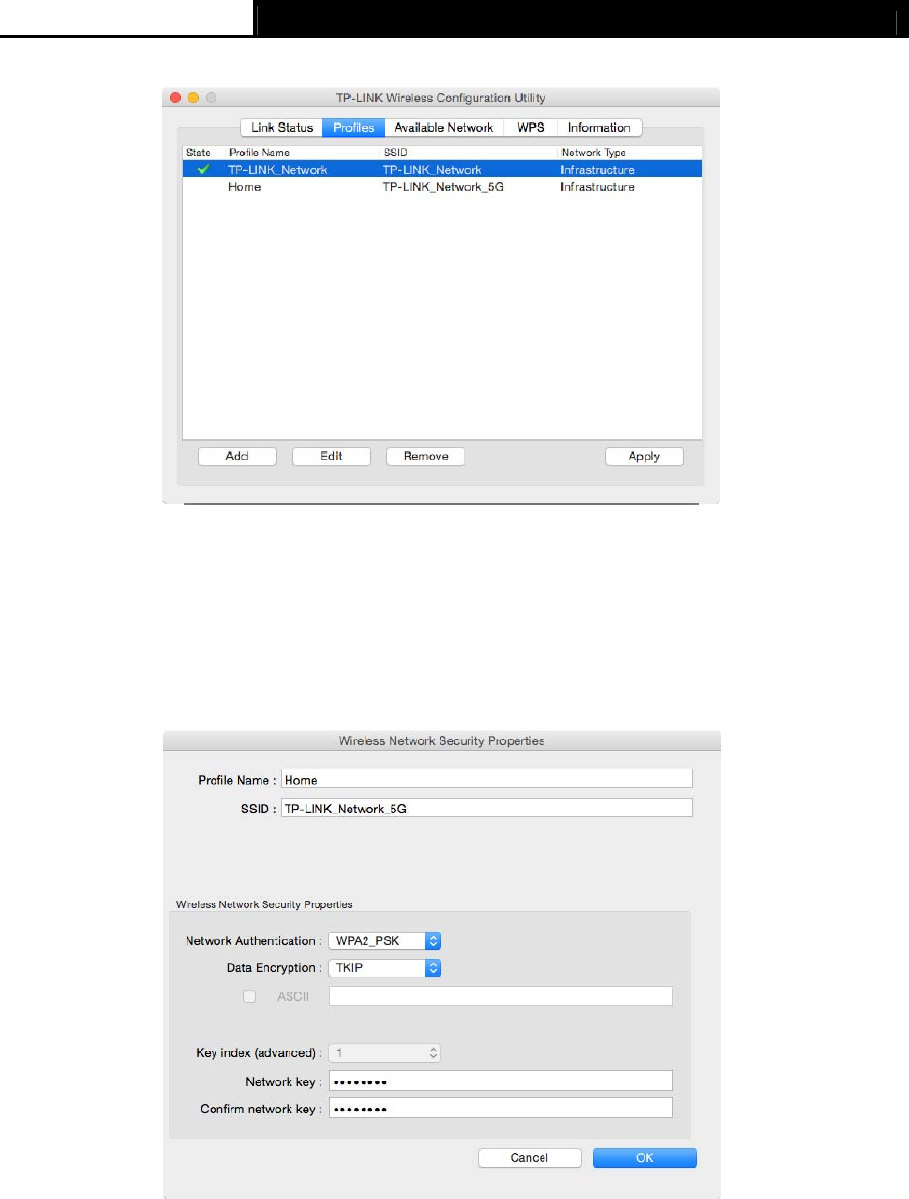
Archer T9UH AC1900 High Gain Wireless Dual Band USB Adapter User Guide
17
To add a new profile
1. Click the Add button, and then a new window will open.
2. Complete the settings as shown in the following figure, and click OK.
Profile Name - Enter a name for your profile, such as Home, Office, Coffeehouse. Do not enter
the profile name that already exists.
SSID - Enter the name of your Wi-Fi network.
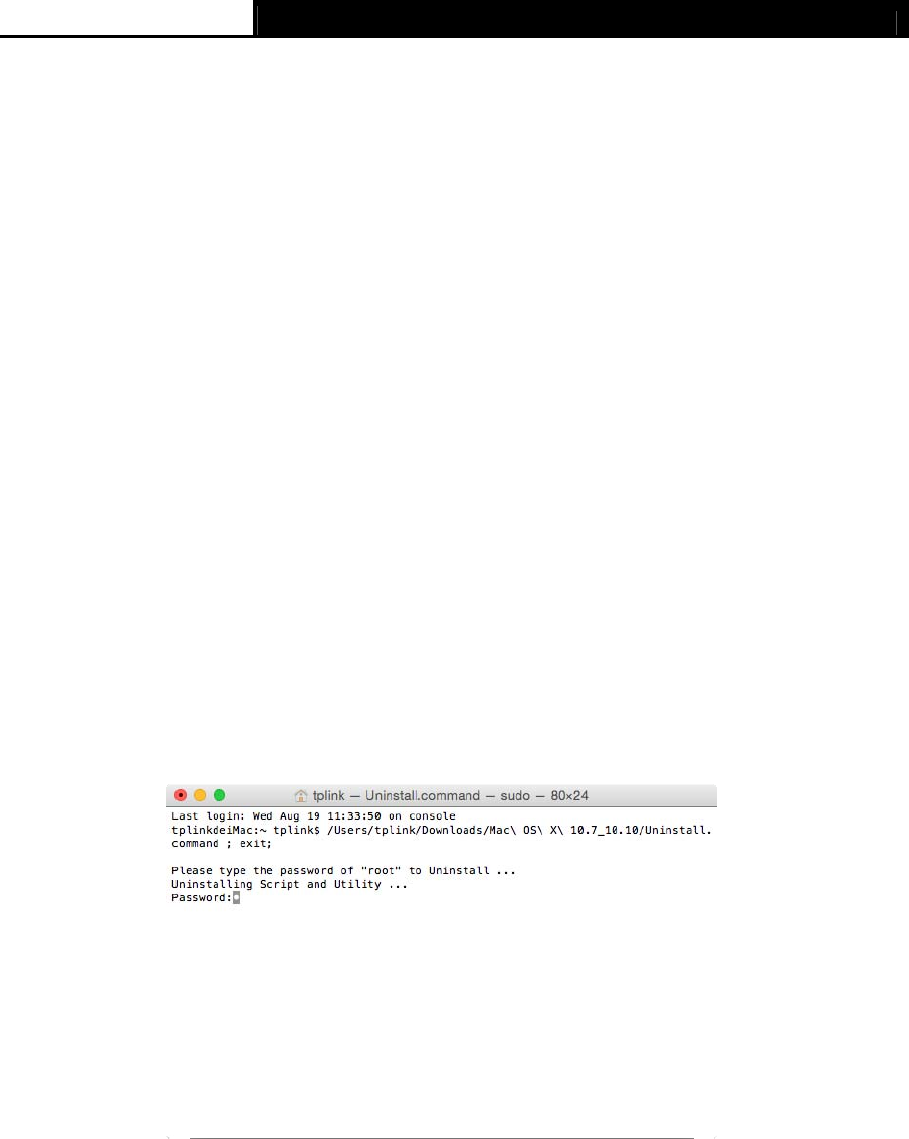
Archer T9UH AC1900 High Gain Wireless Dual Band USB Adapter User Guide
18
Wireless Network Security Properties:
Select or enter the corresponding wireless settings, including Network Authentication, Data
Encryption and Network key, which should be the same as those of your Wi-Fi network. Then
click OK.
To join a Wi-Fi network
If you want to join a Wi-Fi network that listed in the profile screen, select the profile and click
Apply button in the bottom right corner.
To manage an existing profile
If you want to change the name or the wireless settings of an existing profile, select it and click
the Edit button in the Profile screen, then you can edit the settings of this profile. If you want to
delete a profile that you no longer use, select it and click the Remove button.
4.4 Uninstall Driver and Utility
1. Insert the CD and run it manually.
2. Go to Archer T9UH > Mac OS X Driver > Mac OS X 10.7_10.10.zip >
Uninstall.command.
3. As shown in the figure below, a command window will pop up. Type the password of the
root user to uninstall the software.
4. Wait till the “Process completed” shows up, then restart your computer to finish the
uninstallation.

Archer T9UH AC1900 High Gain Wireless Dual Band USB Adapter User Guide
21
Appendix A: Specifications
Normal
Interface USB 3.0 Interface
Standards IEEE802.11a; IEEE802.11b; IEEE802.11g; IEEE802.11n;
IEEE802.1x, IEEE802.11ac
Operating System Windows XP, Windows 7, Windows 8, Windows 8.1,
Windows 10
Mac OS X 10.7 - 10.10
Linux
Throughput 2.4GHz:600Mbps (Maximal)
5GHz: 1300Mbps (Maximal)
Data Security WEP, WPA / WPA2, WPA-PSK / WPA2-PSK
Frequency* 2.4~2.4835GHz, 5.18~5.24GHz,
5.26~5.32GHz, 5.500~5.700GHz, 5.745~5.825GHz
Antenna
Environmental and Physical
Working Temperature 0℃~40℃ (32℉~104℉)
Storage Temperature -40℃~70℃(-40℉~158℉)
Working Humidity 10%~90% RH, Non-condensing
Storage Humidity 5%~90% RH, Non-condensing
* 1. Only 2.412GHz~2.462GHz is allowed to be used in USA, which means only channel 1~11 is
available for American users to choose.
* 2. Rules on the use of 5GHz band channels may vary according to different national laws.
Four dual-band antennas with 3dBi@2.4GHz and 4dBi@5GHz
(I-PEX)

Archer T9UH AC1900 High Gain Wireless Dual Band USB Adapter User Guide
22
Appendix B: Glossary
802.11ac - IEEE 802.11ac is a wireless computer networking standard of 802.11.This
specification will enable multi-station WLAN throughput of at least 1 gigabit per second. This
is accomplished by extending the air interface concepts embraced by 802.11n: wider RF
bandwidth, more MIMO spatial streams, multi-user MIMO, and high-density modulation (up to
256 QAM).
802.11n - 802.11n builds upon previous 802.11 standards by adding MIMO (multiple-input
multiple-output). MIMO uses multiple transmitter and receiver antennas to allow for increased
data throughput via spatial multiplexing and increased range by exploiting the spatial diversity,
perhaps through coding schemes like Alamouti coding. The Enhanced Wireless Consortium
(EWC) was formed to help accelerate the IEEE 802.11n development process and promote a
technology specification for interoperability of next-generation wireless local area networking
(WLAN) products.
802.11g - Specification for wireless networking at 54 Mbps using direct-sequence
spread-spectrum (DSSS) technology, using OFDM modulation and operating in the
unlicensed radio spectrum at 2.4GHz, and backward compatibility with IEEE 802.11b devices,
and WEP encryption for security.
802.11b - The 802.11b standard specifies a wireless product networking at 11 Mbps using
direct-sequence spread-spectrum (DSSS) technology and operating in the unlicensed radio
spectrum at 2.4GHz, and WEP encryption for security. 802.11b networks are also referred to
as Wi-Fi networks.
802.11a - Specification for wireless networking at 54 Mbps using OFDM modulation and
operating in radio band at 5GHz.
Ad hoc Network - An ad hoc network is a group of computers, each with a Wireless Adapter,
connected as an independent 802.11 wireless LAN. Ad hoc wireless computers operate on a
peer-to-peer basis, communicating directly with each other without the use of an access point.
Ad hoc mode is also referred to as an Independent Basic Service Set (IBSS) or as
peer-to-peer mode, and is useful at a departmental scale or SOHO operation.
Infrastructure Network - An infrastructure network is a group of computers or other devices,
each with a Wireless Adapter, connected as an 802.11 wireless LAN. In infrastructure mode,
the wireless devices communicate with each other and to a wired network by first going
through an access point. An infrastructure wireless network connected to a wired network is
referred to as a Basic Service Set (BSS). A set of two or more BSS in a single network is
referred to as an Extended Service Set (ESS). Infrastructure mode is useful at a corporation
scale, or when it is necessary to connect the wired and wireless networks.
SSID - A Service Set Identification is a thirty-two character (maximum) alphanumeric key
identifying a wireless local area network. For the wireless devices in a network to
communicate with each other, all devices must be configured with the same SSID. This is

Archer T9UH AC1900 High Gain Wireless Dual Band USB Adapter User Guide
23
typically the configuration parameter for a wireless PC card. It corresponds to the ESSID in
the wireless Access Point and to the wireless network name. See also Wireless Network
Name and ESSID.
WEP - (Wired Equivalent Privacy) - A data privacy mechanism based on a 64-bit or 128-bit or
152-bit shared key algorithm, as described in the IEEE 802.11 standard. To gain access to a
WEP network, you must know the key. The key is a string of characters that you create.
When using WEP, you must determine the level of encryption. The type of encryption
determines the key length. 128-bit encryption requires a longer key than 64-bit encryption.
Keys are defined by entering in a string in HEX (hexadecimal - using characters 0-9, A-F) or
ASCII (American Standard Code for Information Interchange – alphanumeric characters)
format. ASCII format is provided so you can enter a string that is easier to remember. The
ASCII string is converted to HEX for use over the network. Four keys can be defined so that
you can change keys easily.
Wi-Fi - A trade name for the 802.11b wireless networking standard, given by the Wireless
Ethernet Compatibility Alliance (WECA, see http://www.wi-fi.net), an industry standards
group promoting interoperability among 802.11b devices.
WPA - (Wi-Fi Protected Access) - A wireless security protocol uses TKIP (Temporal Key
Integrity Protocol) encryption, which can be used in conjunction with a RADIUS server.
